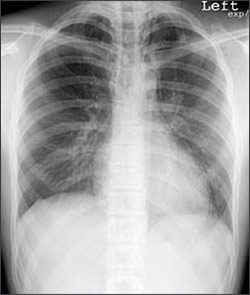
Am Fam Physician. 2006;74(3):473-474
A 16-year-old patient presented to the emergency department with sudden onset of chest pain and shortness of breath while playing basketball. There was no history of trauma. Physical examination revealed an otherwise healthy male in no acute distress with a blood pressure of 129/66 mm Hg, heart rate of 71 beats per minute, respiratory rate of 20 breaths per minute, and a pulse oximetry reading of 97 percent. Swelling and crepitus were noted in the neck. On auscultation, a crunching sound was noted over the precordium with each heartbeat. Pulmonary examination was unremarkable, and results of electrocardiography were normal. Chest radiography was performed (see accompanying figure).

Question
Discussion
The answer is B: pneumomediastinum. Physical examination demonstrated subcutaneous emphysema and Hamman's sign, the audible crunching accompanying each heartbeat. These findings are characteristic of pneumomediastinum. Chest pain and dyspnea are the most common symptoms. The chest radiograph shows a radiolucent outline of the mediastinum as well as the continuous diaphragm sign.1
Pneumomediastinum is extra-alveolar air within the mediastinum. Numerous etiologies have been identified, including penetrating or crushing chest trauma, rapid shearing of the fixed carina, and increased intrabronchial pressure.2 Other causes include esophageal rupture in Boerhaave's syndrome, repeated Valsalva maneuver during inhalation drug use, or colonic perforation during colonoscopy.3–5
Spontaneous pneumomediastinum is rare, especially episodes not related to chest trauma, tracheobronchial or esophageal procedures, mechanical ventilation, cardiac catheterization, or chest surgery. Pneumomediastinum mainly affects previously healthy young men.6 Pulmonary alveolar rupture is the most common etiology. Potential precipitating conditions include asthma, vomiting, Valsalva maneuver, esophageal rupture, and intense exercise or sports participation.7
Rapid recovery is common, and interventions such as needle decompression and ventilatory assistance rarely are needed. An important associated or causative condition to rule out is spontaneous pneumothorax. In this patient, a small left pneumothorax was visible on computed tomography. Etiologies include alveolar rupture secondary to straining against a closed glottis or rupture of subpleural blebs.8
Aortic dissection is a rare but potentially fatal occurrence. Prevalence increases with age and is higher in men. Risk factors include hypertension, trauma, and collagen-vascular disorders (e.g., Marfan syndrome). Patients may present with sudden, severe, tearing abdominal or back pain. Radiographic findings may include mediastinal widening.
Atypical chest pain is a diagnosis of exclusion. In this case, there is a clear diagnosis based on chest radiography.
Reactive airways disease, in particular exercise-induced asthma, could present with chest pain and shortness of breath after exercise. Wheezing does not have to be present. This patient had no history of reactive airways disease, and chest radiography provided the diagnosis. However, some cases of spontaneous pneumomediastinum are associated with asthma or other pulmonary disease, leading some experts to recommend pulmonary function testing after recovery.7
The presentation of esophageal rupture is similar to that of pneumomediastinum. Subcutaneous emphysema and chest pain, especially worsened by swallowing, are common. However, the patient's history usually includes trauma or forceful vomiting.
| Condition | Characteristics |
|---|---|
| Aortic dissection | Sudden tearing pain with widened mediastinum; possible history of collagen-vascular disorders or trauma |
| Pneumo-mediastinum | Air within the mediastinum; subcutaneous emphysema, Hamman's sign, chest pain, dyspnea |
| Atypical chest pain | Exclusionary diagnosis once cardiopulmonary etiologies have been ruled out; may be musculoskeletal, gastrointestinal, or psychological |
| Reactive airways disease | Inflammatory response to allergens, infection, climate, exercise; dyspnea with or without wheezing |
| Esophageal rupture | Often seen as air within the mediastinum; usually history of trauma or forceful vomiting; chest pain, especially worsened by swallowing |